Introduction:
Chest exercises with dumbbells on a bench press day, the gym rats in your life could have told you about “blasting their pecs. However, building muscle in your chest is crucial for both functional and cosmetic reasons.
Your chest muscles enable you to raise, drop, twist, and move your arms in nearly every way, among other complex upper body actions. Your chest muscles are used when you open doors, move big boxes, use a vacuum, or even just breathe. It is simpler to move around in the world and less likely to sustain certain ailments if they are stronger.
Chest exercises with dumbbells workouts are a part of any complete fitness regimen. Working your muscles against resistance—whether it comes from a barbell, weight machines, or gravity—is also the best method to build strength. Since your arms must operate independently of one another and your stronger side cannot “cheat” to help move a single weight source, dumbbells are an incredibly effective resistance training tool for upper body activity.
Get a pair of dumbbells and attempt these ten top dumbbell chest workouts if you’re seeking for a fantastic method to build all of the muscles in your chest.

What muscles make up your chest?
The pectoralis major, which may be used to raise and drop your arm in front of you as well as rotate it inward, is the most frequently thought-of muscle in the chest exercises with dumbbells. The pectoralis minor, which is situated beneath the pectoralis major, is also in charge of maintaining the stability of the shoulder blade.
Last but not least is the serratus anterior, which is situated on the lateral surfaces of the rib cage, deep under the pectorals and is in charge of moving your shoulder blades forward, enabling you to reach forward.
These 10 dumbbell chest workouts are the greatest
Chest exercises with dumbbells, 1. Dumbbell chest press
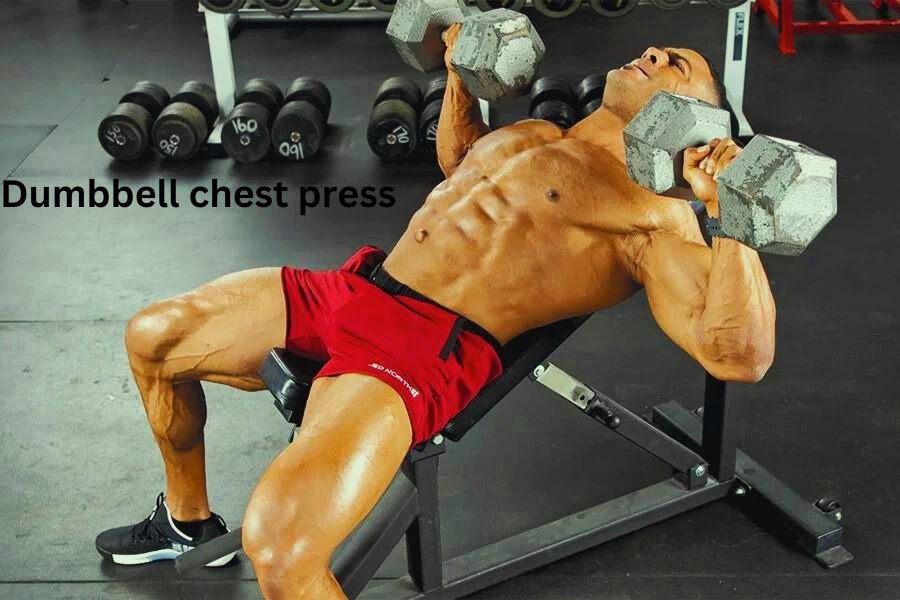
The dumbbell chest press is a simple yet very common exercise. It is a very effective upper body strengthening exercise that works all the major muscles of the chest as well as your shoulders and, when performed correctly, your back.
Take two dumbbells and chest exercises with dumbbells that are relatively heavy and set them in front of you to do the chest press. Once you’re seated on a weight bench, pick up the dumbbells from the floor and gradually lower yourself until you’re flat on the bench. With your elbow positioned just below your shoulder, your wrists neutral, and your knuckles facing the wall behind you, raise your arms into a straight angle.
Straighten your arms and press both weights into the air while squeezing your chest exercises with dumbbells. To prevent impinging on the shoulder joint, aim the weights to align slightly in front of the shoulder, directly above your sternum (imagine a “nipple line”). Lift the weights slowly back to the starting position while pulling your shoulder blades inward, or “squeezing together.”
You need to be able to complete a set of ten to twelve repetitions without having to take a break. For your following set, go with heavier weights if you are able to lift them more.
Use your right and left arms alternately, or unilaterally—that is, complete a set of reps on one arm and then another set on the other—to provide variation to the chest press exercise.
Use a mat to do the workout if you don’t have access to a bench.
2. Dumbbell chest fly

Another really well-liked option for toning every muscle in the chest is the dumbbell chest fly.
Choose two light to moderately heavy chest exercises with dumbbells and set them in front of you to do the dumbbell chest fly. Once you’re seated on a weight bench, pick up the dumbbells from the floor and gradually lower yourself until you’re flat on the bench. With your hands facing each other and positioned exactly above your sternum, raise both dumbbells into the air. Gently drop the weights to the side while maintaining your arm posture locked, extending your chest, and drawing in your shoulder blades.
Engage your chest muscles to return the weights to their starting position when you have reached the end of your range. Complete a set of 10–12 repetitions, aiming for muscular exhaustion on the last rep.
Try switching up your left and right arms or finishing all of the reps on one arm before going on to the next to add some variation to the chest fly.
Should you lack a weight bench, you may carry out the chest fly exercise by lying down on a mat.
3. Dumbbell pullover
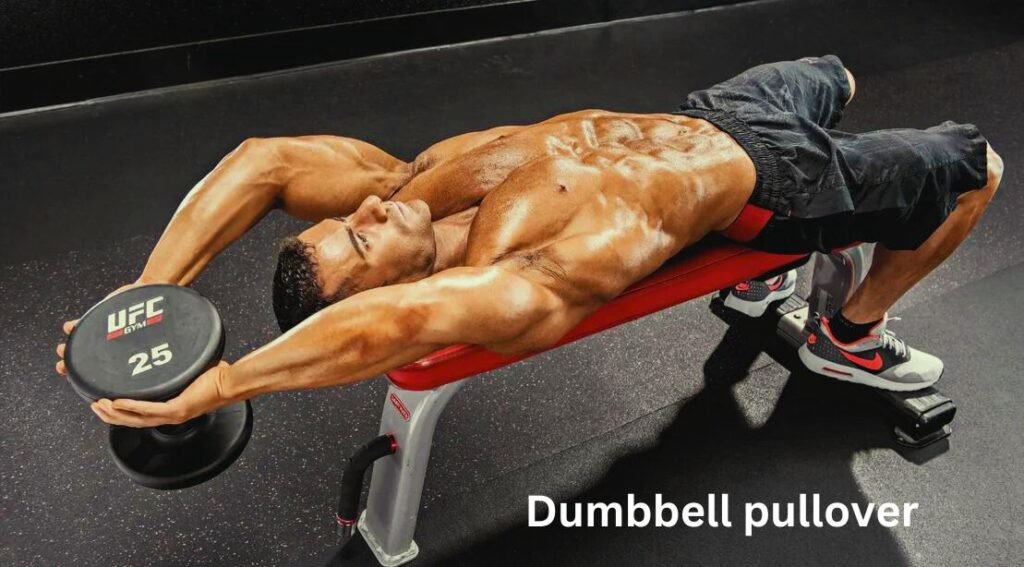
The pullover may be utilized to strengthen the chest in addition to occasionally targeting the latissimus dorsi, a major muscle in the back.
Pick up one dumbbell and chest exercises with dumbbells that is relatively heavy to do the dumbbell pullover. Grip the dumbbell vertically by one end and slowly lower yourself onto a weight bench so that it is directly over your sternum. Depress your shoulder blades, plant your feet firmly on the ground, and gradually drop the dumbbell behind your head.
When the dumbbell reaches the end of its range, contract your chest muscles to return it to its initial position. Continue until you reach muscular exhaustion at the conclusion of the set, doing 10–12 repetitions.
You can execute the dumbbell pullover on the floor without a weight bench, but your range of motion will be limited. Take a look at what transpired after our fitness editor performed fifty dumbbell pullovers every day for a week.
4. Dumbbell svend press

If you spend enough time in the gym, you’ll eventually see someone performing a svend press. Although these chest exercises with dumbbells is commonly done with plates to prepare for bench pressing, it may also be difficult on its own if you use one or two dumbbells.
Choose two dumbbells that are mild to moderately heavy to do the Svend press with. Squeeze them together while holding them by the handles in a vertical orientation. Engage your core while standing with your feet about hip-width apart. After bringing the dumbbells in close to your sternum, stretch your arms and press the weights straight out of your body while maintaining their pressure.
After ten to twelve repetitions, stop when your muscles get fatigued.
Press the dumbbells away from you diagonally, both upward and downward, to give variation to the Svend press.
Use a single dumbbell to complete the Svend press if you have just one or if your dumbbells are circular rather than hexagonal. Hold the dumbbell horizontally and push into either end with your hands.
5. Standing cross-body dumbbell raise
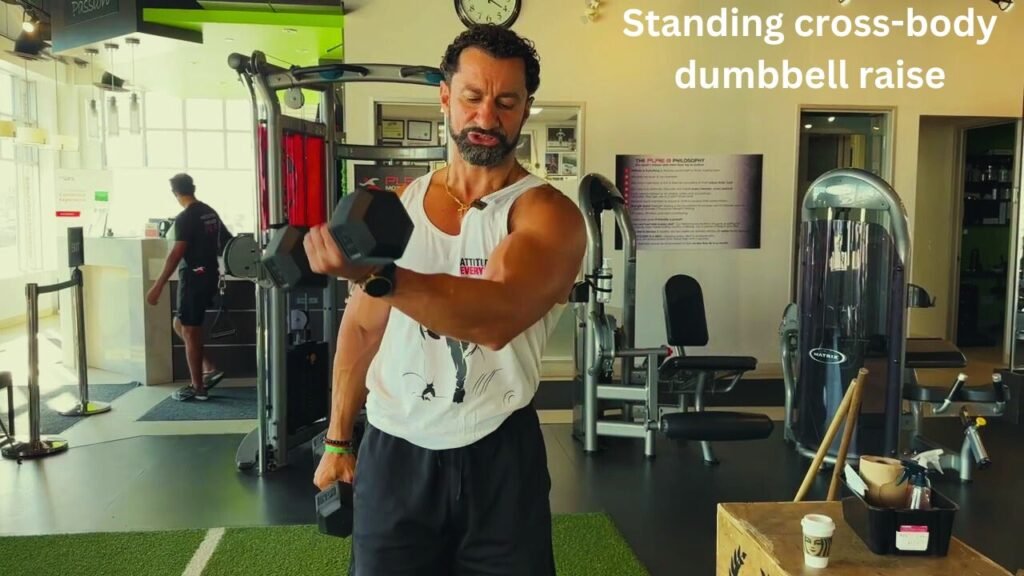
The standing cross-body dumbbell raise is an excellent exercise to work your chest’s bottom region.
Select a light to moderately heavy chest exercises with dumbbells for the standing cross-body dumbbell raise. Place your feet hip-width apart and tense your core as you stand. Squeeze the right pectoral muscle by gently raising the weight with an underhand grip toward the left shoulder while holding the dumbbell in your right hand and bending your elbow slightly. Return to the starting position by lowering.
Do 10–12 repetitions, then switch to your left arm to finish the set.
6. Crush grip dumbbell press
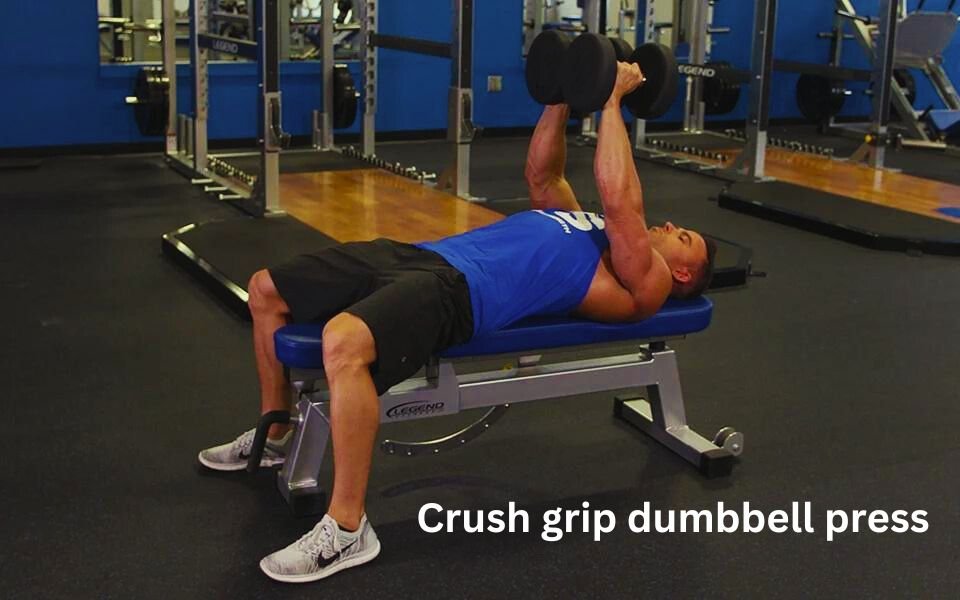
Like the svend press, the crush grip dumbbell press increases the difficulty of a pressing motion by contracting the chest muscles continuously over the whole workout.
Take two dumbbells and chest exercises with dumbbells are relatively heavy and set them in front of you to do the crush grip dumbbell press. After settling into a weight bench, grab the dumbbells. Reduce to a laying posture gradually. Dumbbells should be held vertically, with the ends of each bell touching and your sternum in line. After you “crush” the dumbbells together, press both of them toward the ceiling while tensing your chest muscles. Regress the weights gradually to the initial position while maintaining pressure on the dumbbells.
Until your muscles become fatigued, repeat for ten to twelve times.
Use a mat to do the crush grip dumbbell press if you don’t have access to a weight bench.
Use a single dumbbell for the crush press if you have it or if your dumbbells are circular rather than hexagonal. Hold the weight horizontally and apply pressure with your hands to either end.
7. Decline dumbbell chest press

The decline dumbbell press is a variant on the traditional chest press that focuses on the lower chest.
Take hold of two dumbbells and chest exercises with dumbbells that are relatively heavy to complete the decline dumbbell chest press. Step down onto a declining weight bench, place your feet in the leg braces, and gently lower yourself to a laying posture. Position the dumbbells so that your knuckles face the wall behind you and aim them straight over your sternum. With your elbows positioned just below your shoulders and your arms in a straight angle, retract your shoulder blades and gradually drop the dumbbells to your sides.
Up until you have muscular exhaustion, repeat for ten to twelve times.
Having a spotter place the dumbbells in your hands before you start and remove them at the end of your set may be required, depending on the weight you’ve chosen.
You may switch up the decline dumbbell chest press by using your left and right arms alternately, or you can work on one arm for the entire set before switching to the other.
8. Incline dumbbell chest press
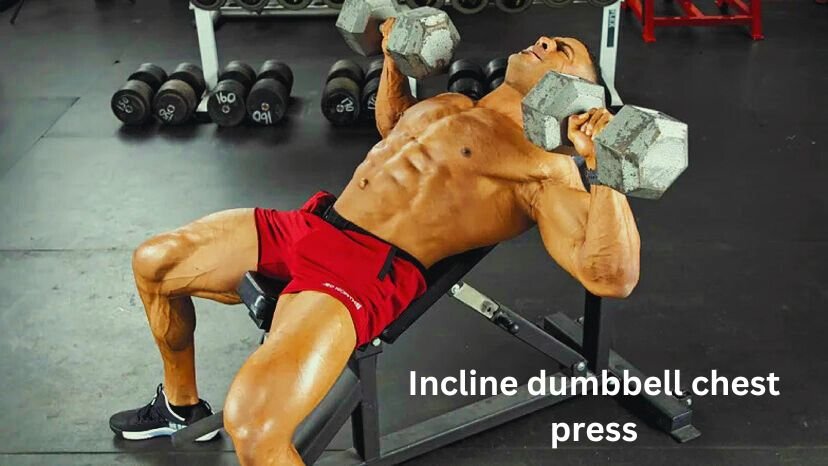
Another version of the chest press that focuses on the top part of the chest is the incline dumbbell chest press.
A weight bench should be inclined to lie approximately midway between flat and upright. After grabbing the weights and taking a seat on the bench, carefully lower yourself onto it.
While facing the wall behind you with your knuckles facing the weights, raise them to your shoulders. Lift the weights up toward the ceiling while maintaining their alignment with your upper chest. Return to the starting position by lowering.
Continue until you reach muscular exhaustion on the final repetition, which should be 10–12 repetitions.
You may vary the incline chest exercises with dumbbells chest press by using your left and right arms alternately, or you can perform a whole set with one arm and then switch to the other.
9. Dumbbell push up
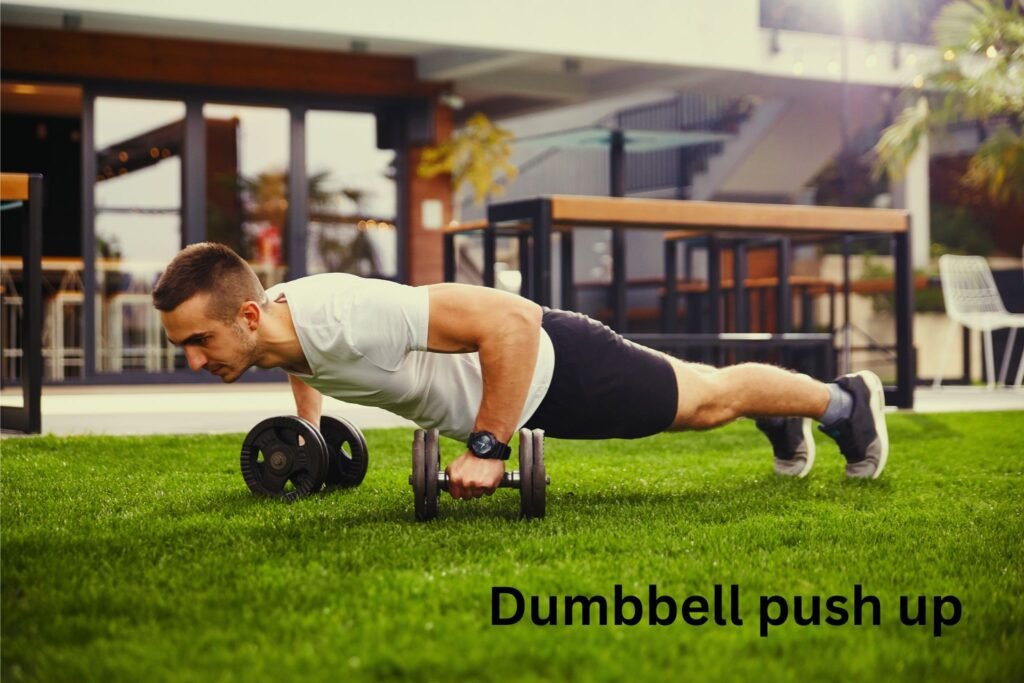
One of the finest functional workouts for strengthening your complete upper body is the push-up. You may train even more of your chest during push-ups by extending the range of action by placing a dumbbell under each hand.
Grasp two dumbbells that are relatively heavy and set them in front of you on the floor, vertically inclined, to do a dumbbell push-up. Take hold of each handle, place your neutral wrists precisely behind your shoulders, and then take a step back to assume a plank posture. Make sure your hips and chest remain in alignment as you gradually lower yourself toward the floor while maintaining an engaged core and a neutral lower back.
Push yourself back up to the beginning position when you’ve reached the end of your range. Maintaining perfect form, repeat for 10–12 repetitions or until muscle failure is achieved.
You may alter this workout by lowering your knees to the ground. Use larger-diameter dumbbells to advance this workout and extend your range of motion.
Alternate how your chest exercises with dumbbells are positioned on the floor to offer variation to the dumbbell push-up.
10. Reverse grip dumbbell chest press

Another variant on the classic chest press that targets the lower chest area (and gives your biceps a run for their money) is the reverse grip dumbbell chest press.
Put two fairly heavy dumbbells in front of you to do the reverse grip dumbbell chest press. Grasp the weights while seated on a weight bench, then gradually lower yourself to a laying posture. Chest exercises with dumbbells at your sides and your elbows bent slightly in the direction of your rib cage, face the wall in front of you while performing this exercise. Squeeze the weights toward the sky while maintaining your lower chest in line with the dumbbells. Return the weights to their initial positions gradually.
Repeat until you reach muscular failure at the conclusion of your set, completing 10–12 repetitions.


